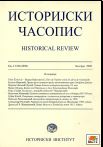Средњовековно утврђење на локалитету Градина у Радаљеву код Ивањице
Medieval Fortification in Gradina Site in Radaljevo near Ivanjica
Author(s): Dejan Bulić, Dejan CrnčevićSubject(s): History
Published by: Istorijski institut, Beograd
Keywords: archaeological probes; Gradina; prehistory; fortification; 14th century; župa Moravica; "land" Moravice; derbend; archaic maiolica; pottery
Summary/Abstract: Due to its extraordinary strategic position, Gradina, whose original name is unknown, controlled the valley of the Moravica River, which was an important communication path from Užice to Sjenica and towards the Ibar River valley. The irregular foundation of the town measures 28 by 93 metres, and the most elevated point of the fort lies at 653 metres. Remnants of the rampart and a circular tower clearly testify to the existence of the original division into the upper and the lower section of the town. Gradine – Trešnjevica in the vicinity of Ivanjica underwent archaeological explorations on two occasions in 2006 and 2008. A somewhat larger structure, most probably a church, was identified under the today’s church. The exploration of the fort provided basic evidence of the construction method and the width of the walls. At places, though smaller in size, the wall was up to 4 or 5 metres tall. The fact that surrounds were used in the construction of the wall indicates that it originates from the late Medieval period. The tower located on the eastern acssess point was of irregular circular shape, preserved up to 2.6 metres in height. Remains of a fireplace and an unusually large number of pottery suggest that the tower served as a kitchen within this fortification. Apart from the existence of the fort, the imortance of the road that went through the Moravica Valley is further emphasized by the Turkish tax registers, citing that the position was guarded by local villagers (derbendžije). The locality was part of the then Moravica District. The finding of the archaic majolica on the floor of the tower, which is the first such case in Serbia, as well as the monochromatic enameled specimens, enable a somewhat more accurate dating of the ceramic materials bearing features of the 14th and 15th century – in the latter half of the 14th century. The findings of the prehistoric pottery at the base of the fort make the locality important from the aspect of several different eras.
Journal: Историјски часопис
- Issue Year: 2012
- Issue No: 61
- Page Range: 67-103
- Page Count: 37
- Language: Serbian

